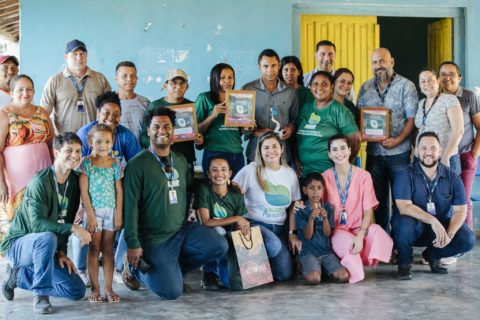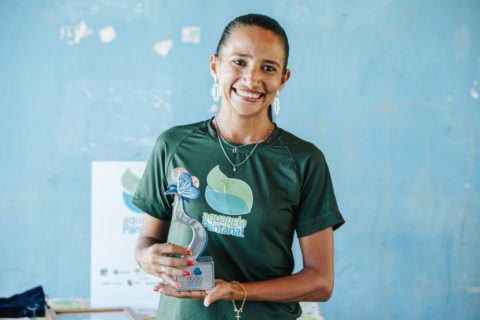
Aquarela Pantanal Initiative receives award for Best Example of Social Mobilization in favor of the environment
-
Corredor Azul
The Aquarela Pantanal Initiative, a project gathering several institutions and families from the Pantanal communities of Capão do Angico, located in the municipality of Poconé , and São Pedro de Joselândia, in Barão do Melgaço (both located in the state of Mato Grosso), was one of the winners of the XIII Hugo Werneck Award for Environment and Sustainability, promoted by the Sou Ecológico magazine. The project was awarded for the “Best Example of Social Mobilization” category as it promotes the recovery of the natural richness in the Pantanal.
The award is a recognition of the commitment of all engaged institutions, highlighting the role of winners projects in environmental causes, as the AquaREla Pantanal Initiative. The project was implemented three years ago in the heart of the Pantanal biome, central west region of Brazil,focused in recovering 46 hectares within the largest private reserve in Brazil, the RPPN Sesc Pantanal, with 108 thousand hectares. This initiative has being supported by GEF Terrestre, Corredor Azul Program (PCA – Wetlands International Brasil) and Mupan – Women in Action in the Pantanal.

According to Rafaela Nicola, office head of Wetlands International Brasil and technical-scientific director of Mupan, the award is an indicator that the work is on the right track to increasingly understand the wetlands dynamics and the best strategies for conservation. “This work is only possible because of the women from two traditional communities who embraced this Initiative with us. The Aquarela Pantanal has this characteristic of female protagonism since the women are in charge of the nurseries, research, management, execution and planning of activities as a whole”, she added.
The purpose of Aquarela Pantanal is to produce native seedlings from the biome in order to recover areas affected by the fire within the Private Natural Heritage Reserve – RPPN Sesc Pantanal, the largest RPPN in the country, while generating income and community development. Two nurseries were built for the production of native seedlings within the communities through the project, with technical support and training. In addition, the workers were paid a grant for the work developed in the nurseries. Thus, the project contemplates the 3 pillars of sustainability: social, environmental and economic.
At the moment, there are 10 families directly participating in the project’s activities. However, Natalice da Costa, a nursery worker in the community of Capão do Angico, points out that the entire community benefits from the actions. “The Aquarela Pantanal is a breath of hope, not only for the animals and plants that suffered so much with the fire, but it also brings us new strength as people, especially us women. Because of the project, we started moving and working together again. It has helped our community to realize its potential, as well as all the things we can do when we unite”.
For Miriam Amorim, a nursery worker from São Pedro de Joselândia, the project was a turning point in her life. “We have been doing such a beautiful job, recovering and conserving our Pantanal. I feel very honored and happy to be a part of it. I’m proud of myself because I have received this recognition with the award, as it stimulates and encourages us to continue. The project has changed my life as well as my community’s. Today, we are more aware of the fact that we are part of the environment and that when you take care of it, everyone can benefit. I hope the project grows and gets to involve more and more people”, the nursery worker said.

The ceremony took place on February, 28th, in Belo Horizonte (MG), and had the Sesc Pantanal Socio-Environmental Pole manager, Cristina Cuiabália, representing the Initiative at the event, On March 3rd, the Aquarela nursery workers received certificates from the Sesc Pantanal Socio-Environmental Pole. The meeting was held in the community of Capão do Angico and it was attended by representatives of the community associations involved in the Initiative.
“We were chosen among 117 projects across the country. Our Initiative is the only one from the Pantanal biome receiving the award. A recognition of this importance on the national scene is very representative and symbolic. Because we saw the birth of a protection network for the Pantanal, from the ashes of the fires of 2020, formed by several actors, with a lot of resilience, strength and unity. It is a collaborative project, involving many hands and hearts, and we are very proud and grateful for the recognition”, as Cristina Cuiabália commented.
Aquarela Pantanal – The “Recovery of Riverside Pantanal Forests: benefiting water, soil, fish and populations around the RPPN Sesc Pantanal” project, also called the “Aquarela Pantanal” Initiative, is a collective work that involves Mupan – Women in Action in the Pantanal, Wetlands International Brasil, the Sesc Pantanal Socio-Environmental Pole – an initiative of the CNC/Sesc/Senac system, the Pantanal Research Center (CPP), and the National Institute of Science and Technology of Wetlands (INAU/ UFMT).
The AquaREla Pantanal is financed by: 1) the Global Environment Fund (GEF) through the Project Restoration and Sustainable Management Strategies to Enhance Caatinga, Pampa and Pantanal Biodiversity (GEF Terrestrial), coordinated by the Ministry of Environment (MMA), it has the Inter-American Development Bank (IDB) as the implementing agency, and the Brazilian Biodiversity Fund (FUNBIO) as the executing agency; & 2) the DoB Ecology via the Corredor Azul Program of Wetlands International.
Corredor Azul Program – Created by Wetlands International, with a 10 year development period, 2017-2027, the Corredor Azul Program (PCA) aims to protect biodiversity and ensure the connectivity of people, nature and economies in a cross-border territory, covering 3 large humid areas of the Paraná-Paraguay System, namely: Pantanal, Esteros de Iberá and Delta do Paraná.
Extending for 3,400 km, from the Brazilian Pantanal, it also involves Bolivia and Paraguay until it flows into the Paraná Delta, in Argentina, forming the Paraná-Paraguay System (Blue Corridor, in Portuguese; Corredor Azul), one of the world’s last examples of a large free-flowing and continuous river system. The Program´s name is an allusion to the large volume of water that circulates within these important wetlands in South America.
